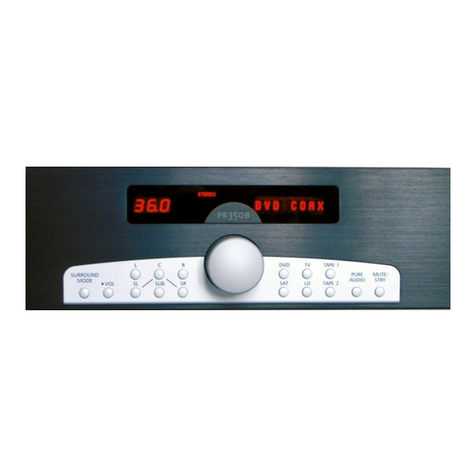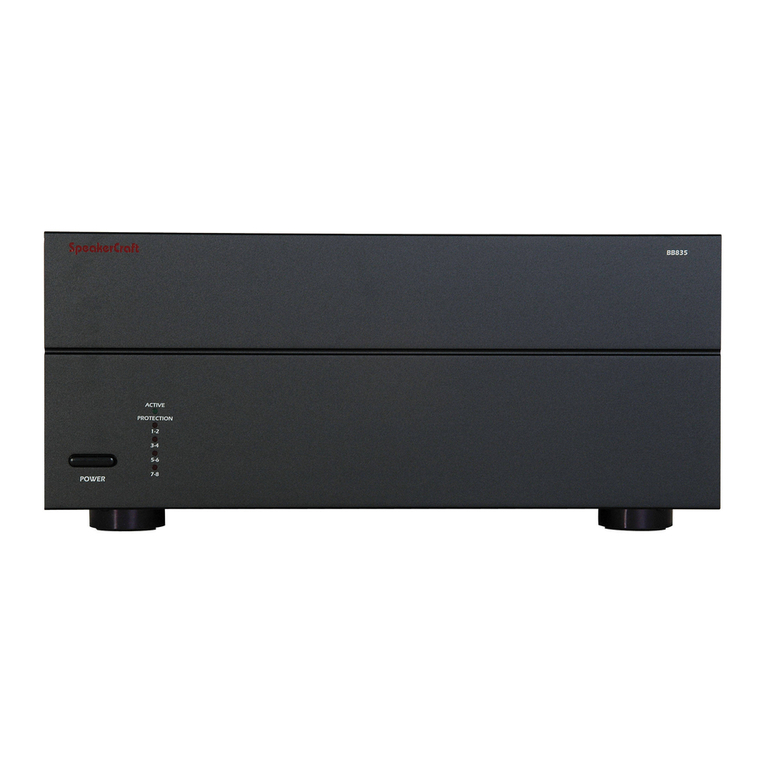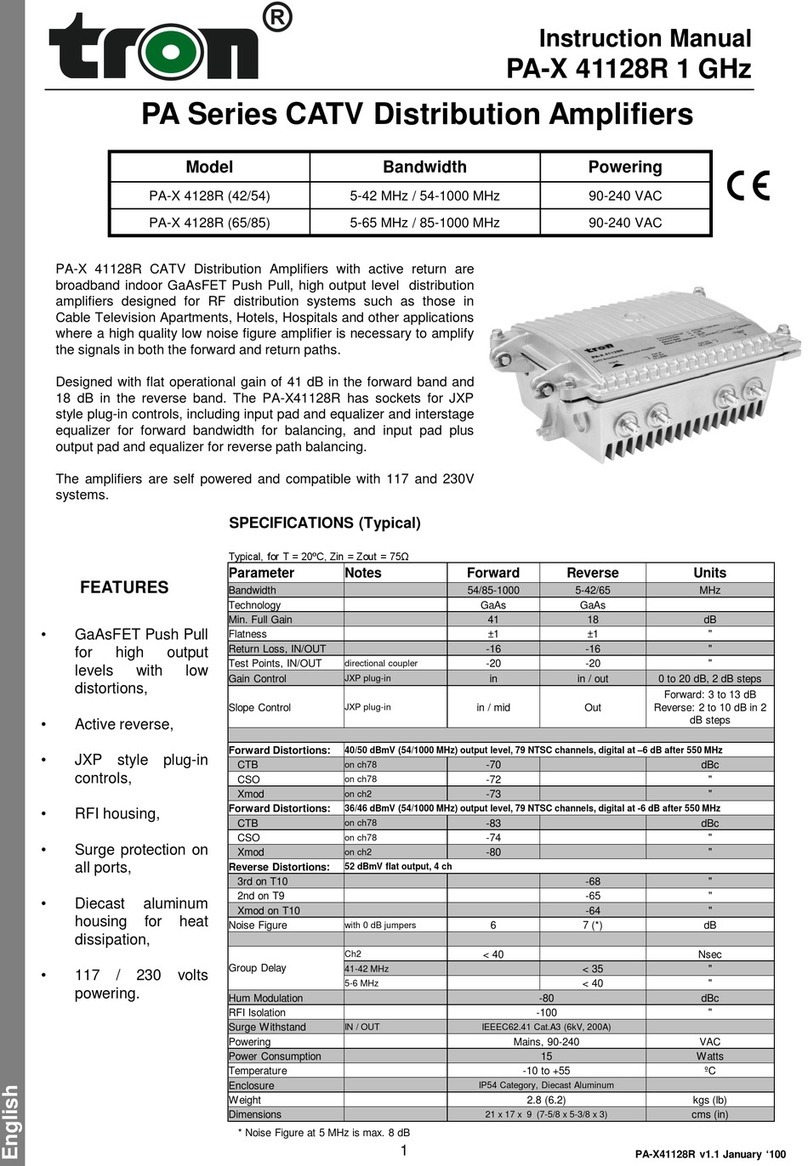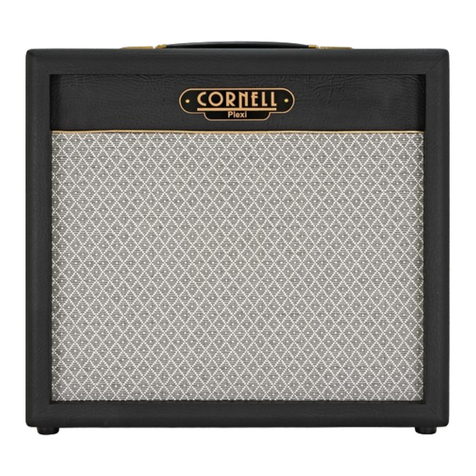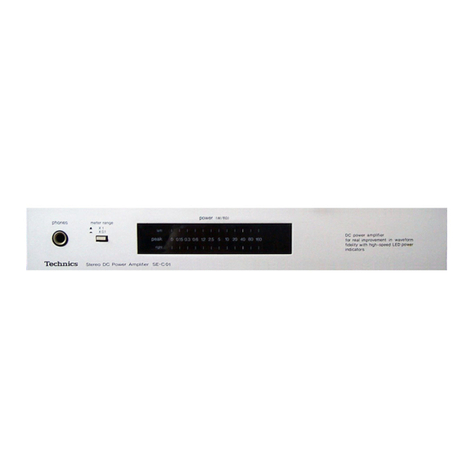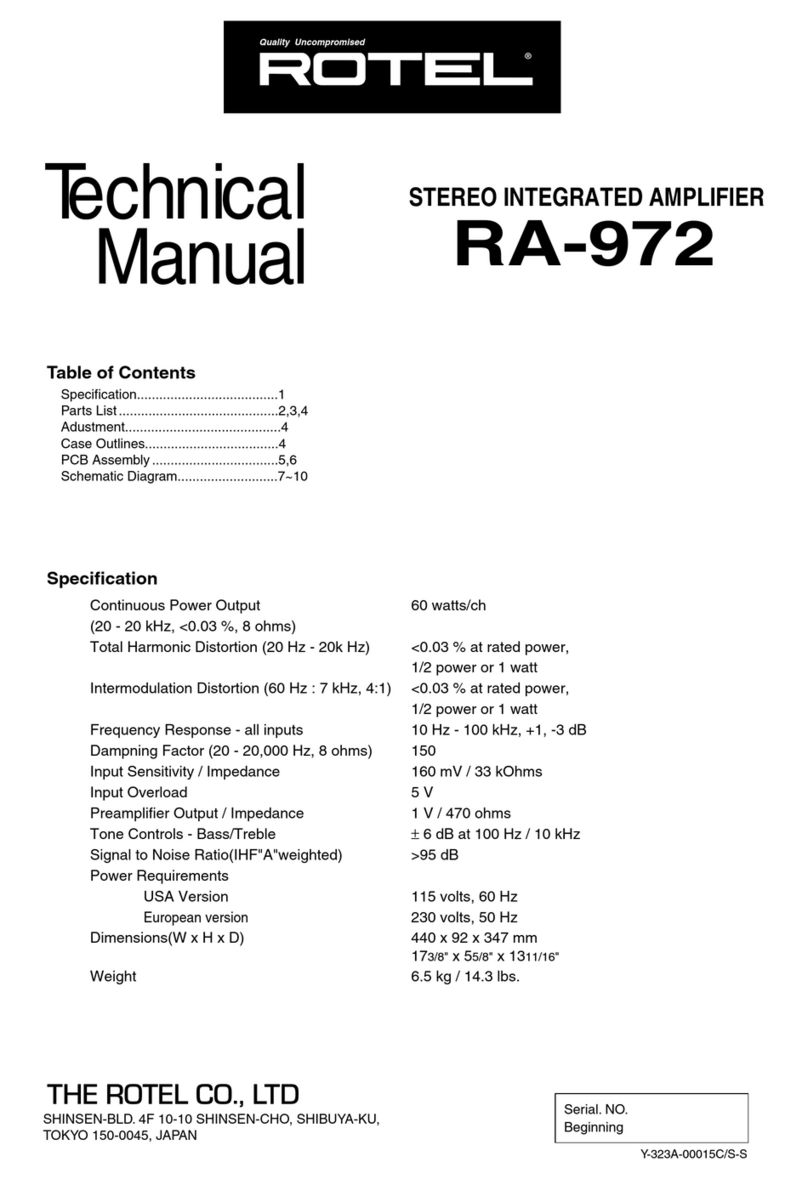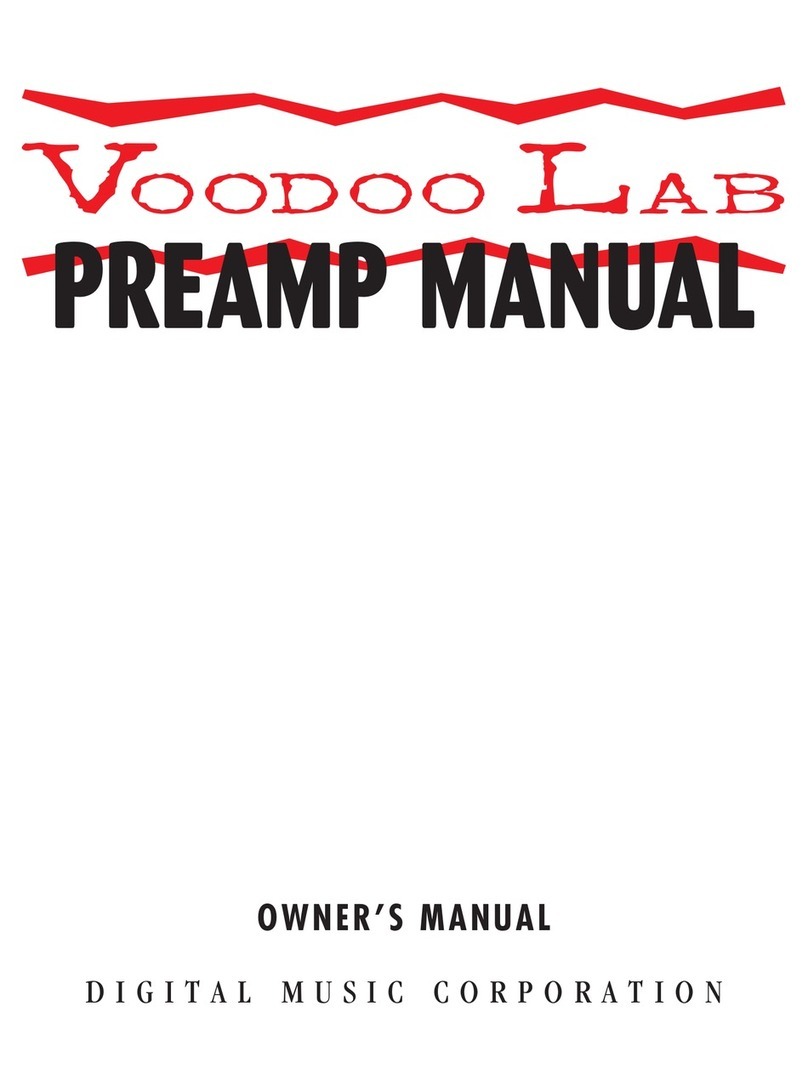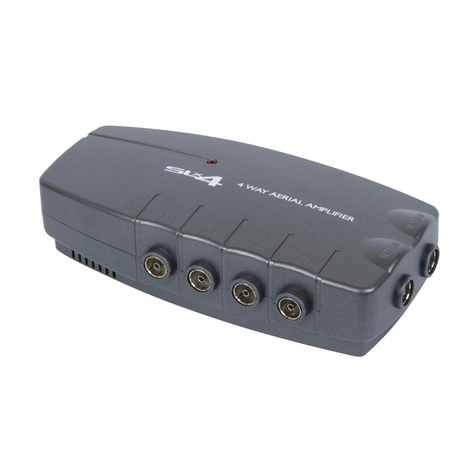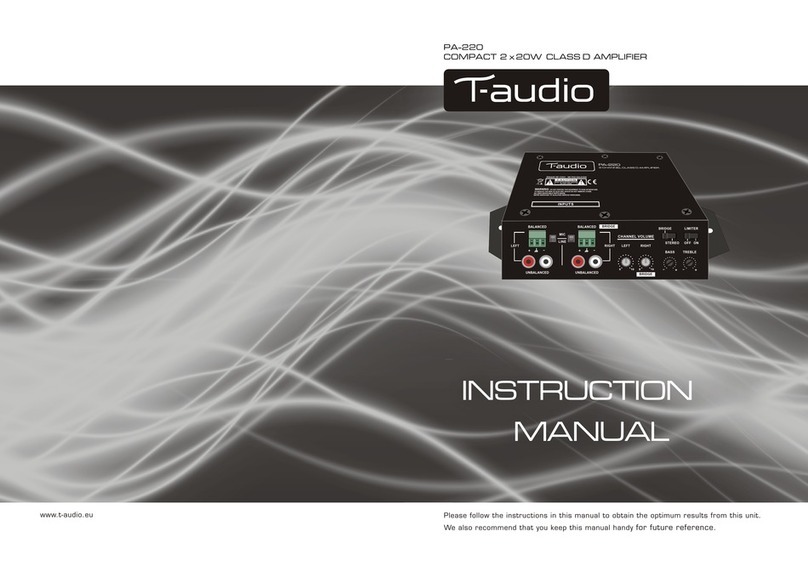Thule Audio SPHERE AV100 User manual

Manufactured under license from Dolby Laboratories. ”Dolby”, ”ProLogic II” and the double-D symbol are trademarks of Dolby Laboratories.
Confidential unpublished works. © 1992-1997 Dolby Laboratories Inc. All rights reserved.
Manufactured under license from Digital Theater Systems, Inc. US Pat. No. 5,451,942, 5,956,674, 5,974,380, 5,978,762, 6,487,535 and other
U.S. and world-wide patents issued and pending. "DTS", "DTS-ES Extended Surround" and "Neo:6" are trademarks of Digital Theater
Systems, Inc. Copyright 1996, 2003 Digital Theater Systems, Inc. All Rights Reserved.
Thule Audio ApS has the right to make changes without prior notice
Owner’s Manual
SPHERE AV100, AV120, AV100S and AV120S


___________________________________________________________________________
page 3
INDEX
OVERVIEW OF REMOTE CONTROL......................................................................................................... 4
OVERVIEW OF REAR AND FRONT PANELS ........................................................................................... 5
OVERVIEW OF CONTROL PANEL AND DISPLAY ................................................................................. 9
CONGRATULATIONS WITH YOUR NEW SPHERE AV100/120! ......................................................... 10
0. INSTALLATION ......................................................................................................................................... 12
1. INPUT SELECTION ................................................................................................................................... 12
2. VOLUME CONTROLS .............................................................................................................................. 13
3. ZONE 2 ......................................................................................................................................................... 14
4. DELAY ......................................................................................................................................................... 14
5. SURROUND MODES ................................................................................................................................. 16
5.1 D
OLBY
D
IGITAL
....................................................................................................................................... 16
5.2 DTS ......................................................................................................................................................... 17
5.3 D
OLBY
P
RO
L
OGIC
II ................................................................................................................................ 18
5.4 PCM
AND ANALOGUE INPUTS
.................................................................................................................. 18
5.5 S
IDE
C
HANNELS
....................................................................................................................................... 19
6. CONFIG MENU .......................................................................................................................................... 19
6.1 S
PEAKERS
................................................................................................................................................ 20
6.2 I
NPUTS
..................................................................................................................................................... 21
6.3 N
OISE
....................................................................................................................................................... 21
6.4 C
ROSSOVER FREQUENCY
.......................................................................................................................... 21
6.5 E
XTENDED
S
URROUND
............................................................................................................................. 21
6.6 D
YNAMIC RANGE COMPRESSION
............................................................................................................... 21
6.7 V
OLUME SCALE
........................................................................................................................................ 22
6.8 S
AVING SET
-
UP PARAMETERS IN THE MEMORY BANK
................................................................................ 22
6.9 R
ETURN TO FACTORY DEFAULT SETTING
.................................................................................................. 23
6.10 OSD (O
NLY APPLICABLE FOR
AV100S
AND
AV120S.) ......................................................................... 23
6.11 SPDIF OUT........................................................................................................................................... 23
6.12 P
OWER
A
MP CONTROL
........................................................................................................................... 23
6.13 P
RO
L
OGIC
II .......................................................................................................................................... 24
6.14 V
IDEO INPUT OUTPUT
(
ONLY ACTIVE IN
AV100S/AV120S) ................................................................... 24
6.15 V
IDEO MISCELLANEOUS
(
ONLY ACTIVE IN
AV100S/AV120S)................................................................ 24
TECHNICAL SPECIFICATIONS................................................................................................................. 25
7.0 YOUR NOTES ........................................................................................................................................... 26
APPENDIX A: SPECIAL FUNCTIONS ....................................................................................................... 27
A.1 A/D
LEVEL
.............................................................................................................................................. 27
A.2 E
LECTRICAL
(
COAXIAL
)
VERSUS OPTICAL DIGITAL INPUT
......................................................................... 27
A.3 A
UTOMATIC FAILURE CORRECTION SYSTEM
............................................................................................ 27

STBY MUTE
[MODE]
TAPE 1
DIM
L
SL SUB SR
CR
LD TAPE 2
[STATUS]
TV
SAT
DVD
[CONFIG]
ENTER
VOL
PURE A.
VOL
VOL standby | mute -20dB | increase volume
REMOTE CONTROL
change light | return to master volume | decrease volume
left | center | right
surround left | subwoofer | surround right
DVD player | sattelite receiver | TV-set
laser disc | audio/video tape1 | audio/video tape2
pure audio input
enter config mode
navigate in config menu
change surround mode
received input status
channel balance
double push: delay
input selection

SURROUND OUTPUTS ZONE 2ZONE 2
MADE IN DENMARK BY THULE AUDIO SURROUND AMPLIFIER
SC SL
CL
DIGITAL I/O DATA I/O SURROUND OUTPUTS ZONE 2
PURE AUDIO INPUT
CAUTION - RISK OF ELECTRIC SHOCK - DO NOT OPEN!
LSL CSC
SSL
C
SL
L
RSR
SR
RSUB SUB SSR
SUB
SR
R
SAT TV LD/CD TAPE1 TAPE2IN DVD
OUT SAT
DVD LD/CD
TV OUT
RS232
L
R
220-230 V 50-60 Hz
Manufactured under licence from Dolby Laboratories Licensing Corporation.
“Dolby”, “AC-3” and the double-D symbol are trademarks of Dolby Laboratories
Licensing Corporation. Copyright 1992 Dolby Laboratories, Inc. All rights reserved.
MODEL: SPHERE AV100
Manufactured under license from Digital Theater Systems,
Inc. US Pat. No. 5,451,942, 5,956,674, 5,974,380, 5,978,762
and other world-wide patents issued and pending. “DTS”,
“DTS-ES Extended Surround” and “Neo:6” are trademarks
of Digital Theater Systems, Inc. Copyright 1996, 2000
Digital Theater Systems, Inc. All Rights Reserved.
HIGH EFFICIENCY - VIRTUAL CLASS A
FRONT PANEL AND REAR PANEL - AV100
analog audio inputs
to DSP
power
connector
connector to control other
Thule Audio equipment or
RS232 communication
pre-out surroundelectrical digital
connectors
optical digital inputs
zone 2 out
6 x speaker outputs
inputs bypassing
DSP circuits
SURROUND
MODE
PURE
AUDIO
MUTE/
STBYCHANNEL INPUTVOL
PURE
AUDIO
MUTE/
STBY
pure audio input
INPUT input selector
SURROUND
MODE
VOL
CHANNEL channel balance
short push: change surround mode
2 sec. push: input format information
back to master volume short push: mute to “40”
2 sec. push: standby
CONTROL PANEL
display: see page 9

SURROUND OUTPUTS ZONE 2
ZONE 2
MADE IN DENMARK BY THULE AUDIO SURROUND AMPLIFIER
SC SL
CL
DIGITAL I/O DATA I/O SURROUND OUTPUTS ZONE 2
PURE AUDIO INPUT
CAUTION - RISK OF ELECTRIC SHOCK - DO NOT OPEN!
LSL CSC
SSL
C
SL
L
RSR
SR
RSUB SUB SSR
SUB
SR
R
SAT TV LD/CD TAPE1 TAPE2IN DVD
OUT SAT
DVD LD/CD
TV OUT
RS232
L
R
220-230 V 50-60 Hz
Manufactured under licence from Dolby Laboratories Licensing Corporation.
“Dolby”, “AC-3” and the double-D symbol are trademarks of Dolby Laboratories
Licensing Corporation. Copyright 1992 Dolby Laboratories, Inc. All rights reserved.
MODEL: SPHERE AV120
Manufactured under license from Digital Theater Systems,
Inc. US Pat. No. 5,451,942, 5,956,674, 5,974,380, 5,978,762
and other world-wide patents issued and pending. “DTS”,
“DTS-ES Extended Surround” and “Neo:6” are trademarks
of Digital Theater Systems, Inc. Copyright 1996, 2000
Digital Theater Systems, Inc. All Rights Reserved.
HIGH EFFICIENCY - VIRTUAL CLASS A
FRONT PANEL AND REAR PANEL - AV120
analog audio inputs
to DSP
power
connector
connector to control other
Thule Audio equipment or
RS232 communication
pre-out surroundelectrical digital
connectors
optical digital inputs
zone 2 out
6 x speaker outputs
inputs bypassing
DSP circuits
volume control |control panel: see page 9
display: see page 9

SURROUND
MODE
PURE
AUDIO
MUTE/
STBYCHANNEL INPUTVOL
PURE
AUDIO
MUTE/
STBY
pure audio input
INPUT input selector
SURROUND
MODE
VOL
CHANNEL channel balance
short push: change surround mode
2 sec. push: input format information
back to master volume
CONTROL PANEL
SURROUND OUTPUTS ZONE 2
MADE IN DENMARK BY THULE AUDIO
SURROUND AMPLIFIER
SC SL
CL
DIGITAL I/O DATA I/O SURROUND OUTPUTS ZONE 2
PURE AUDIO INPUT
CAUTION - RISK OF ELECTRIC SHOCK - DO NOT OPEN!
LSL CSC
SSL
C
SL
L
C/B
bC/RrY/G
RSR
SR
RSUB SUB SSR
SUB
SR
R
SAT
SAT
TV
TV
LD/CD
LD/CD
TAPE1
TAPE1 TAPE2
TAPE2IN
IN DVD
DVD
DVD
OUT
OUT SAT
DVD
OUT OUT
SAT
LD/CD
TV OUT
RS232
LS-VIDEO
COMPOSITE
R
220-230 V 50-60 Hz
Manufactured under licence from Dolby Laboratories Licensing Corporation.
“Dolby”, “AC-3” and the double-D symbol are trademarks of Dolby Laboratories
Licensing Corporation. Copyright 1992 Dolby Laboratories, Inc. All rights reserved.
MODEL: SPHERE AV100 S
Manufactured under license from Digital Theater Systems,
Inc. US Pat. No. 5,451,942, 5,956,674, 5,974,380, 5,978,762
and other world-wide patents issued and pending. “DTS”,
“DTS-ES Extended Surround” and “Neo:6” are trademarks
of Digital Theater Systems, Inc. Copyright 1996, 2000
Digital Theater Systems, Inc. All Rights Reserved.
HIGH EFFICIENCY - VIRTUAL CLASS A
FRONT PANEL AND REAR PANEL - AV100S
S-video inputs
composite/component
video inputs
analog audio inputs
to DSP
power
connector
connector to control other
Thule Audio equipment or
RS232 communication
pre-out surroundelectrical digital
connectors
optical digital inputs
zone 2 out
6 x speaker outputs
inputs bypassing
DSP circuits
RGB/component
video output
display: see page 9
short push: mute to “40”
2 sec. push: standby

SURROUND OUTPUTS ZONE 2
MADE IN DENMARK BY THULE AUDIO
SURROUND AMPLIFIER
SC SL
CL
DIGITAL I/O DATA I/O SURROUND OUTPUTS ZONE 2
PURE AUDIO INPUT
CAUTION - RISK OF ELECTRIC SHOCK - DO NOT OPEN!
LSL CSC
SSL
C
SL
L
C/B
bC/RrY/G
RSR
SR
RSUB SUB SSR
SUB
SR
R
SAT
SAT
TV
TV
LD/CD
LD/CD
TAPE1
TAPE1 TAPE2
TAPE2IN
IN DVD
DVD
DVD
OUT
OUT SAT
DVD
OUT OUT
SAT
LD/CD
TV OUT
RS232
LS-VIDEO
COMPOSITE
R
220-230 V 50-60 Hz
Manufactured under licence from Dolby Laboratories Licensing Corporation.
“Dolby”, “AC-3” and the double-D symbol are trademarks of Dolby Laboratories
Licensing Corporation. Copyright 1992 Dolby Laboratories, Inc. All rights reserved.
MODEL: SPHERE AV120 S
Manufactured under license from Digital Theater Systems,
Inc. US Pat. No. 5,451,942, 5,956,674, 5,974,380, 5,978,762
and other world-wide patents issued and pending. “DTS”,
“DTS-ES Extended Surround” and “Neo:6” are trademarks
of Digital Theater Systems, Inc. Copyright 1996, 2000
Digital Theater Systems, Inc. All Rights Reserved.
HIGH EFFICIENCY - VIRTUAL CLASS A
FRONT PANEL AND REAR PANEL - AV120S
S-video inputs
composite/component
video inputs
analog audio inputs
to DSP
power
connector
connector to control other
Thule Audio equipment or
RS232 communication
pre-out surroundelectrical digital
connectors
optical digital inputs
zone 2 out
6 x speaker outputs
inputs bypassing
DSP circuits
RGB/component
video output
volume control |control panel: see page 9
display: see page 9

SL
SL
SURROUND PURE MUTE/
MODE
SURROUND
MODE
AUDIO STBY
SR
SR
SAT
SAT
LD
LD
TAPE 2
TAPE 2
SUB
SUB
L
L
C
C
R
R
DVD
DVD
TV
TV
TAPE 1
TAPE 1
VOL
VOL
short push: surround left channel balance
2 sec. push: surround left channel delay
/ enter
left channel balance
/ left
Dolby Digital surround
Dolby ProLogic II surround
2 channel stereo
Adjustments Zone 2
DTS digital surround
short push: change surround mode
2 sec. push: input format information
short push: back to master volume
2 sec. push: enter config mode
/ exit config menu
short push: center channel balance
2 sec. push: center channel delay
/up
right channel balance
/ right
short push: surround right channel balance
2 sec. push: surround right channel delay
DVD player
remote sensor
multi functional display
standby indicator
surround mode
TV-set
audio/video tape1
audio/video tape2
laser disc player or
CD player
sattelite receiver pure audio input
short push: mute -20dB
2 sec push: standby
short push: subwoofer balance
2 sec push: LFE balance
/ down
main function
/ function in config mode CONTROL PANEL - AV120, AV120S
DISPLAY
MUTE/
STBY
PURE
AUDIO
volume level
100: max
0: min ZONE 2
ZONE 2
STEREO
STEREO

___________________________________________________________________________
page 10
Congratulations with your new SPHERE AV100/120 integrated surround amplifier!
The SPHERE AV100/120 offers you an outstanding range of features and sound
performance due to its use of highly advanced technology.
We feel confident that the AV100/120 will give you many enjoyable moments while
watching films and listening to music.
To ensure you the full benefit of this advanced product, please read this manual
carefully before you proceed.
The SPHERE AV100/120 includes the following features:
- Pure analogue input with 6 channels
- 32 – 96 kHz PCM stereo
- 96kHz Dolby ProLogic II decoding
- Dolby Digital decoding with auto detection
- DTS 5.1, DTS 6.1 discrete, DTS 6.1 matrix and DTS 24bit/96kHz decoding with
auto detection
- Extended precision decoder improves dynamic range for 24-bit DTS up to
115dBA
- New Motorola DSP 56367 with 150 MIPS (Million Instructions Per Second)
- Upgradeable design for coming sound formats
- 10x Burr Brown 24-bit/192kHz D/A converters
-
True differential D/A conversion in all channels
- Direct-key access (AV120 only) to channel trim adjustments with 0.5dB
adjustment step
Precision volume control for all 10 channels with 0.5dB adjustment steps and
100dB range
- Delay adjustment for centre, surround left, surround right and surround centre
channels
- Common delay (Lip sync) for all channels up to 5ms to compensate for possible
video delays
- Direct-key access to input selection (AV120 only)
- Most inputs can be assigned as analogue, electrical digital or optical digital
- Sensitivity for analogue inputs to DSP is adjusted automatically for improved
dynamic range
- Test Noise signal for the individual channels’ volume trim
- Flexible speaker settings with extensive bass management
- Adjustable crossover frequency (60 – 120Hz) for bass management
- Dynamic range compression for both DTS and Dolby Digital, e.g. for improved
performance in noisy environments
AV100S and AV120S only:
- Component, S-video and composite video switching with 4-line adaptive comb
filter, so that only one RGB or Component video connection to TV / Projector is
necessary.
- Progressive video pass-through with 100MHz bandwidth
- Video encoder with On Screen Display (OSD), which is automatically bypassed
when not used
Each feature is described further in the following pages.

___________________________________________________________________________
page 11
Following formats are used in this manual:
Cursive text indicates display readout, e.g.: CONFIG
Key type is indicated with “”, e.g.: “ENTER” key.
Stereo speakers:
“L” : left speaker
“R” : right speaker
Surround speakers:
“C” : centre speaker placed in front of the listening position
“SL” : surround left speaker placed rear left of the listening position
“SR” : surround right speaker placed rear right of the listening position
Extended surround speakers:
“SC” : surround centre speaker placed back of the listening position.
“SSL” : Left side speaker, placed between L and SL speaker.
“SSR” : Right side speaker, placed between R and SR speaker.
All video specifications apply only for AV100S and AV120S.

___________________________________________________________________________
page 12
0. Installation
Please ensure carefully that all following rules are complied to; otherwise you may void
your warranty and Thule Audio will accept no responsibility for any damages incurred:
- Place the amplifier on a hard and flat surface.
- The ventilation holes should not be covered. There must be at least 10 cm (4
inches) of free air on top of the amplifier. Do not place any other equipment on top
of the amplifier.
-
Do not expose the amplifier to direct sunlight.
-
Do not place the amplifier in warm or dusty environments.
Caution: Because of risk of fire or electric shock, do not expose the amplifier to rain or
moisture.
Caution: Because of risk of electric shock, do not open the amplifier.
1. Input selection
The input selection is very flexible, so it can suit many different home theatre and
stereo installations. It is possible to switch between seven different inputs, which are
directly accessed by keys on the front panel (only AV120) or on the remote control.
Each input can be configured in different ways, shown below with an “X”.
The factory settings are marked with [ ] brackets. Changes to this setting can be
made in the config menu.
INPUTS
DVD
SAT
LD
TV
Tape 1
Tape 2
Pure A.
Analogue
X
X
[X]
[X]
[X]
Coax digital
[X]
[X]
[X]
X
Dig. Direct
X
Optical
X
[X]
Composite
[X]
X
[X]
X
S-video
X
X
[X]
X
[X]
Component
[X]
X
For audio signals, one of four options in the upper three rows must be selected
under the config.input menu.
Similarly, the video inputs configuration must be selected for AV100S/AV120S in the
config.video-input-output menu. After video switching, the built-in adaptive comb
filter converts the selected video source into component or RGB video format.
Therefore, your projector or TV must be set correctly to either RGB or component,
and the “intelligent” video switching in AV100S/120S will take of the rest.
The Pure Audio input will bypass the DSP circuits and is recommended for high
quality music listening in stereo e.g. to a CD player or another analogue source.
Alternatively, for high quality music listening in stereo, connect the digital output from
a CD player or DVD player to one of the available digital inputs in the AV100/120

___________________________________________________________________________
page 13
and use the built-in balanced 24-bit D/A converters. This will bypass the CD-player’s
own normal 16-bit D/A converters and improve playback quality significantly.
The Sphere AV100/120 is also optimised for D/A conversion of the 24bit/96kHz
stereo DVD music discs.
2. Volume controls
The master volume level is set by rotating the volume knob on the front panel or by
using the “VOL ⇑” or VOL ⇓” key on the remote control.
The volume adjustments are scaled, so that at normal listening levels, the setting is
extremely accurate with 0.5dB steps, while at lower levels the step size increases to
allow a more rapid setting. The scaled volume setting is the most convenient for
normal users, and is therefore set as default.
However, it is possible to change the volume to 0.5dB steps for the entire volume
range by changing it in the config.volume menu.
The volume trims between each channel are set under the config.noise menu by
comparing the perceived sound volume from each channel via the built-in noise
generator, so that you can compensate for speaker sensitivity differences and
distances from listening position.
We recommend that the settings for each channel after using the config.noise option
are stored as initial settings for each of the individual Stereo, ProLogic II, Dolby
Digital and DTS memory banks. See further description of the memory banks in
section 5.
However, each surround mode may lead to a different setting of volume trims based
on individual requirements. In Thule Audio’s experience, Dolby Digital and ProLogic
II mode gain can be increased 3 – 6 dB more in the surround speakers than
“measured” under the noise test to obtain a more realistic surround image. Also in
DTS mode, the gain can be increased 2 – 4 dB in the surround speakers. These
more practical settings based on individual requirements can then be stored under
each memory bank for automatic reload depending on chosen surround mode.
Each movie or music source may also lead to a different setting of volume trims.
Therefore it is possible to adjust the volume trim “on the fly” directly by pushing the
channel “L”, “C”, “R”, “SL”, “SUB” or “SR” key on the front panel or remote control.
However, for setting the volume trim from the front panel on AV100/100S, it is
necessary to toggle the “channel” knob.
Subsequently, the extended surround channels “SC”,”SSL” and “SSR” can be
selected for adjusting by using the arrow keys. The channel level can then be
adjusted by rotating the volume knob on the front panel or by pressing the “VOL ⇑”
or VOL ⇓” key on the remote control.
The volume trim settings changed “on the fly” will return to the default settings stored
in the memory banks when the AV100/120 is set into standby or power is turned off.
By pushing the “SUB” key on the front panel or remote in for 2 seconds, the LFE
(low frequency effect) channel is activated for adjusting. The LFE channel is the
bass information, which is sent to the subwoofer or alternatively sent to the “L” and
“R” channels if the subwoofer is deactivated. In this way, it is possible to adjust the

___________________________________________________________________________
page 14
low frequency content even when no subwoofer is present.
The normal display returns 15 sec. after the last action on any of the channel select
keys, or immediately after the ”>VOL” key is pushed.
3. Zone 2
With zone 2, it is possible to redirect the sound to other audio systems, e.g. in the
kitchen or bedroom. The zone 2 has a separate volume control and input selector.
Adjustments for zone 2 are achieved by holding down the same input knob as
currently selected. When e.g. DVD input is selected, hold down the “DVD” knob on
remote or front panel for approximately 1 sec.
Then the ZONE2 indicator becomes active.
Possible inputs are:
SAT ANLG
TVANLG
LD ANLG
TAPE1 ANLG
Z1 -> Z2 (Input selected in the main zone is played in zone 2)
Even if an input is defined as digital in the main zone, the analogue option is chosen
in zone 2.
The operation returns to the main zone 15 sec. after the last adjustment made to
zone 2, or by pressing the ”>VOL” key.
4. Delay
To experience the best surround sound quality, it is important that the sound signal
from all the speakers arrives at the same time at the listening position. If the
listening position is placed closer to the rear surround speakers, the sound from
these speakers will arrive earlier at the listening position. In this case, it is necessary
to delay the sound slightly from the rear speakers.
The important issue here is the difference in distance from the listening position to
the front and rear speakers.
The same problem arises if the centre speaker is placed closer to the listening
position than the front speakers.
On some video sources, the video is delayed compared to the audio, due to video
processing. To compensate for video delay, it is possible to delay all audio channels
up to 5ms. This common delay is called “Lip sync”.
The delays can be set directly from the front panel keys by pushing the “SL”, “SR” or
“C” keys for more than two seconds (only AV120/120S) or double-push on the same
knobs on the remote control.
The display responds briefly with the message DELAY, and afterwards the delay
setting for the selected channel is displayed, e.g. SL 5.0ms. Subsequently, the
delay of the extended surround channel SC and “Lip Sync” can be selected by using
the arrow keys.
The delay can then be changed in steps of 1.0ms by turning the volume knob or

___________________________________________________________________________
page 15
pressing the “VOL ⇑” or “VOL ⇓” key on the remote control.
The normal display will return after 15 seconds from last change or by pushing the
“>VOL” key.
The setting is expressed in milliseconds, but the delay can be calculated from the
physical distance.
A sound wave travels at approx. 340 metres per second, which is equivalent to:
1 foot per 1 millisecond or
1 metre per 3 milliseconds
The following example demonstrates how to calculate the delay setting for SL, SR,
SC and C. The distances mentioned from the listening position to each speaker are
used as an example only and are not meant to be an ideal guideline:
Example Your measurements
Listening position <-> Left speaker: 3.8 m (= 11.4 ft)
Listening position <-> Right speaker: 3.8 m (= 11.4 ft)
Listening position <-> Centre speaker: 2.9 m (= 8.7 ft)
Listening position <-> Left surround speaker: 2.1 m (= 6.3 ft)
Listening position <-> Right surr. speaker: 2.1 m (= 6.3 ft)
Listening position <-> Centre surr. speaker: 1.8 m (= 6.3 ft)
The delays when measuring the distance in metres are then calculated as:
SL delay : (L - SL distance) x 3 = (3.8 - 2.1) x 3 = 5.1ms
SR delay : (R - SR distance) x 3 = (3.8 - 2.1) x 3 = 5.1ms
C delay : (L - C distance) x 3 = (3.8 - 2.9) x 3 = 2.7ms
SC delay : (L - C distance) x 3 = (3.8 - 1.8) x 3 = 6ms
or when the distance is measured in feet:
SL delay : L - SL distance = 11.4 - 6.3 = 5.1ms
SR delay : R - SR distance = 11.4 - 6.3 = 5.1ms
C delay : L - C distance = 11.4 - 8.7 = 2.7ms
SC delay : L - SC distance = 11.4 - 5.4 = 6ms
In this example, we would set the delay at:
SL 5.0ms C 3.0ms SR 5.0ms SC 6.0ms
The above calculations for delay are based on the physical installation and should
be stored as the initial settings in the memory banks (see section 5).
For each surround mode, the preferred settings should be stored in the memory
banks for automatic reload.
The user may still prefer to change delays during playback of a movie, based on
subjective preference in a specific movie.

___________________________________________________________________________
page 16
Hence the delay can also be set “on the fly”.
The intermediate delay settings will return to the default settings stored in the
memory banks when the AV100/120 is set into standby or turned off.
5. Surround Modes
The actual surround mode of the AV100/120 is constantly indicated in the display:
Possible input types:
- Stereo analogue input, PCM or Dolby Digital 2.0 bitstream
- Dolby ProLogic II analogue input, PCM or Dolby Digital 2.0 bitstream
- Dolby Digital Dolby Digital 5.1 bitstream.
- DTS DTS bitstream: 5.1, ES 6.1 discrete or 96kHz 5.1
5.1 Dolby Digital
If a Dolby Digital 5.1 surround bitstream is detected, the AV100/120 will automati-
cally switch to Dolby Digital surround, and the Dolby Digital indicator will light up.
By pushing the “SURROUND MODE” key on the front panel or “mode” on the
remote control, information about which outputs can be expected to be active are
indicated, thus:
L: left speaker
R: right speaker
C: centre speaker
SC: surround centre speaker
SL: surround left speaker
SR: surround right speaker
SW: subwoofer
The number of active outputs will depend on which speakers are activated in the
config.speaker and config.extended surround menu, the received input type
(analogue, PCM, Dolby Digital bitstream or DTS bitstream), and if applicable, also
the selected surround mode.
By pushing the “SURROUND MODE” key for more than one second, information
about the received bitstream will be displayed:
Active audio channels in the received bitstream:
2/0 : L, R are present
2/1 : L, R, Sub are present*
2/2 : L, R, SL, SR are present*
3/0 : L, R, C are present*
3/1 : L, R, C, Sub are present*
3/2 : L, R, SL, SR, C are present*
*If not all speakers are selected under the config.speaker menu, down-mixing will occur automatically.

___________________________________________________________________________
page 17
And the transmission bit rate of the received bitstream:
32k : 32 kbit/sec.
.
.
448k : 448 kbit/sec.
648k : 648 kbit/sec.
768k : 768 kbit/sec. (DTS only)
1411k : 1411 kbit/sec. (DTS only)
1532k : 1532 kbit/sec. (DTS only)
If only two audio channels are active in the received Dolby Digital bitstream (2/0),
the input is assumed to be Dolby ProLogic II when indicated in the bitstream. All
other signals will be interpreted by default as two-channel stereo.
In case of only two active audio channels, the user can toggle between STEREO
and Dolby ProLogic II by an additional short push on the “SURROUND MODE” key.
In this case, both the Dolby Digital and Stereo or the Dolby Digital and Dolby
ProLogic II indicators are turned on. See further information about ProLogic II below.
The normal display will return after 15 sec. from last push on “SURROUND MODE”
or by pushing the ”>VOL” key.
5.2 DTS
Generally, DTS offer the same information and possibilities as Dolby Digital. But
DTS also contains additional possibilities as described in the following.
Several new DTS formats are supported by the AV100/120:
DTS 24-bit:
The DTS encoding resolution is indicated during the DTS lock-on, second line. E.g.
768k/24 means a 768kHz transmission bit rate with 24-bit encoding resolution.
AV100/120 offers extended precision decoding of DTS 24-bitstream to take full
advantage of this increased resolution. For DTS 24-bit, this improves the dynamic
range up to 117dBA, which is fully comparable with DVD-Audio. But DTS 24-
bitstream can be played on normal DVD-Video players. Several mainstream DVD-
Video discs are already encoded with DTS 24-bit, e.g.: “Pearl Harbor”, “Jurassic
Park III”, “Moulin Rouge”, ”Gladiator”, “Lord of the Rings, SE” and “The Haunting”.
DTS ES 6.1 Discrete and DTS ES 6.1 Matrix:
Some DTS discs are encoded with a discrete centre surround channel, called “6.1
Discrete”. If such DVD discs are played, AV100/120 will indicate ES 3/3.1 at lock-on.
This means three front channels (L, C, R) and three surround channels (SL, SC,
SR) are present in the DTS stream. If “6.1 Discrete” is enabled under the
config.extended surround menu, the AV100/120 will automatically activate the
extended surround channel, SC.
Examples of DTS ES 6.1 Discrete DVD discs are “Gladiator” and “The Haunting”.
A few other DVD discs are encoded with DTS ES 6.1 Matrix, where the extended
surround channel, SC, is generated by a matrix process on the surround channels
SL and SR.
One example of a DTS ES 6.1 Matrix disc is “Terminator II, special edition”.

___________________________________________________________________________
page 18
6.1 Matrix:
This DTS mode is actually identical to DTS ES 6.1 Matrix as described above, but
by enabling this mode, the user thereby chooses always to activate the matrix
process on the SL and SR to generate the SC channel.
6.1 Matrix mode will work on Dolby Digital 5.1 streams, too. Try out this feature on
e.g. “Black Hawk Down”.
If the installation contains three rear surround channels, the 6.1 Matrix mode will
improve the surround experience on nearly all 5.1 encoded music and movie
CD/DVD discs. Also, the 6.1 Matrix mode will generate the same sound information
in the SC channel as the THX Surround EX process.
In this case, the user should enable both “DTS 6.1 Discrete” and “6.1 Matrix” under
the config.extended surround menu.
DTS 96kHz:
DTS now offers a new format, where D/A conversion takes place at 96kHz. This is
also supported by AV100/120. The encoding resolution is also 24-bit, thus the
format is normally referred to as “DTS 24/96”. AV100/120 will automatically detect
this type of bitstream and display 96k 5.1. No interaction from the user is necessary.
The 6.1 Matrix mode is automatically disabled and no sound comes from the SC
channel in 96kHz mode.
The “Queen: A night at the opera” DVD in DTS 24/96 demonstrates the potential of
this format.
The DTS 24/96 format is compatible in performance with DVD-Audio, but can be
played on normal DVD-video or CD players.
5.3 Dolby ProLogic II
The AV100/120 supports the new ProLogic II format, which generates surround and
centre channels from a normal stereo signal. Compared to the conventional
ProLogic, the new ProLogic II among other things offers separate SL and SR
channels with full bandwidth information.
Especially on TV-films in stereo, Prologic II can generate a near-Dolby Digital 5.1
experience.
AV100/120 supports separate music and movie modes for ProLogic II. The normal
movie mode will concentrate too much information in the centre channel when
listening to music, therefore the special music mode spreads out the music away
from the centre channel into the L & R speakers.
Thule Audio finds the music mode especially useful for some live recordings, but it is
of course a matter of personal taste, which mode is preferable.
For each input, the user can decide by default whether to use Music or Movie mode,
or to activate ProLogic II under the config.ProLogic II menu.
The surround mode can be toggled between STEREO and Dolby ProLogic II by an
additional short push on the “SURROUND MODE” key.
5.4 PCM and analogue inputs
An analogue input is activated if the letters “ANLG” are indicated after the source
name, e.g. LD ANLG. A PCM input is present if a Dolby Digital or DTS stream is not
auto-detected for a digital input (COAX or OPTO).
An analogue or PCM input stream contains no information about the surround

___________________________________________________________________________
page 19
mode, therefore STEREO is selected as default, unless ProLogic II is selected
under the config.ProLogic II menu.
By pushing the “SURROUND MODE” key or “STATUS” on the remote control for
more than one second, information about received bitstream will be displayed, e.g.
PCM. The AV100/120 can receive PCM inputs with sampling rates from 32kHz up to
96kHz.
For analogue inputs going through the DSP, PCM will also be displayed, because
the digital data from the analogue to digital converter (A/D) is converted into PCM
format with a 96 kHz sampling rate.
For the “PURE AUDIO” input, only ANALOG is displayed. This input completely
bypasses the DSP circuits for the purest analogue reproduction by using the
shortest possible signal path while not adding unnecessary sound processing.
The normal display will return after 15 sec. from last push on “SURROUND MODE”,
or by pushing the ”>VOL” key.
5.5 Side Channels
Thule Audio offers a unique 8.1 channel extension setup for large rooms: Side
channels. By blending the sound from the front speakers and the rear speakers into
to new channels called SSL and SSR, it is possible to create a more continuous
sound sweep for sound effects moving from one end of the room to the other.
The side speakers are simply activated in the config.extended surround menu.
The AV100/120 amplifier contains only six power amplifiers, so it is necessary to
add a two-channel external power amplifier for creating a 8.1 system. It is possible
to redirect the sound from the SSL, SSR processor section into the L and R power
section of AV100/120, and then use a large external power amplifier, e.g. Thule
Audio Space PA350B for powering the L, R channels.
6. Config menu
The config menu is activated by pushing “CONFIG” on the remote control or
pressing the “>VOL” key for 2 seconds on the front panel.
Navigate through the config menu via the remote control by using the arrow keys:
⇑⇓⇒⇐
Enter any sub-menu by pushing “⇒”. Select your desired options by pushing “enter”.
Selected options are underlined on the front panel display and highlighted on the
OSD screen. Exit from a sub-menu with “⇐”. On AV120, it is also possible to
navigate in the config menu with the front panel keys, as the following keys are
reassigned in the config mode:
“L”: ⇐“C”: ⇑“R”: ⇒
“SL”: enter “SUB”: ⇓
It is possible to exit the config menu by several pushes on the “⇐” key, or one push
on the “>VOL” key.
The config menu has two pages. Page 2 is displayed by an additional push on the ⇑

___________________________________________________________________________
page 20
or ⇓key.
In the config sub-menus, even more settings can be activated as described in the
following paragraphs:
6.1 Speakers
The SPHERE AV100/120 contains extensive bass management adjustments, so
that the bass signal can be re-routed to those loudspeakers specifically capable of
handling low-frequency information.
The following selections can be made in the config.speaker menu by using the
navigation keys described above:
Left speaker (L): SMALL or LARGE
Right speaker (R): SMALL or LARGE
Centre speaker (C): SMALL or LARGE or OFF
Surround left speaker (SL): SMALL or LARGE or OFF
Surround right speaker (SR): SMALL or LARGE or OFF
Subwoofer (SUB): ON or OFF
When a speaker is selected as SMALL, the bass signal will be re-routed to the -
subwoofer or the L&R speakers (bass management).
If a speaker is turned off, the sound signal will be sent to the remaining speakers,
which are selected as active (down-mixing).
Special attention should be given to the subwoofer management:
For Dolby Digital 3/2 and DTS input signals, a special low frequency channel (LFE)
is normally included in the bitstream, which is indicated with a “.1” after the input
stream indication, e.g. 3/2 .1 . The LFE channel produces an output signal for the
subwoofer. This means even if all speakers are selected as LARGE, where no
signal normally should be sent to the subwoofer by the bass management, the LFE
input channel overrides this setting and sends out its own subwoofer signal.
For Stereo and ProLogic II, no LFE channel is present. If all speakers are chosen as
LARGE, the bass management will not send any signal to the subwoofer. To obtain
a subwoofer signal in this case, the user can select the subwoofer – max bass ON
option under the config.cross freq menu. Now, the AV100/120 takes the
accumulated full range signal from the L and R channels and sends it to the
subwoofer.
When activating the subwoofer for Stereo and Pro Logic modes, you can decide
between the two following options:
a ) Select L & R (or L,R,C,SL,SR in Pro Logic II) as SMALL. The bass management
will now send the L & R low frequencies to the subwoofer. You can choose
between six different crossover frequencies in the config.cross freq menu.
or
This manual suits for next models
3
Table of contents
Languages:
Other Thule Audio Amplifier manuals
Popular Amplifier manuals by other brands
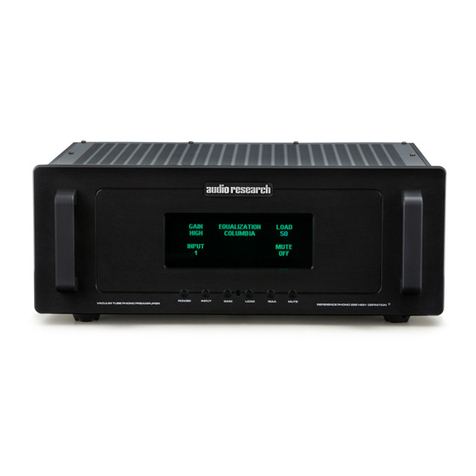
Audio Research
Audio Research Reference Phono 2 SE owner's manual
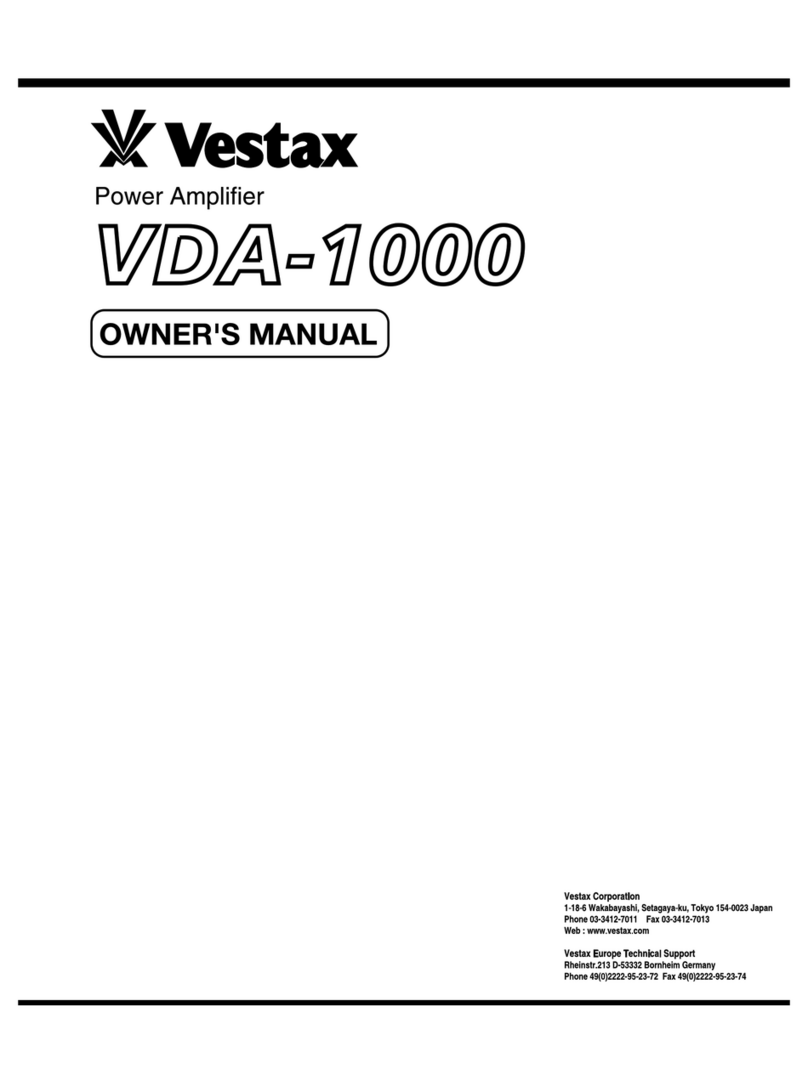
Vestax
Vestax VDA-1000 owner's manual
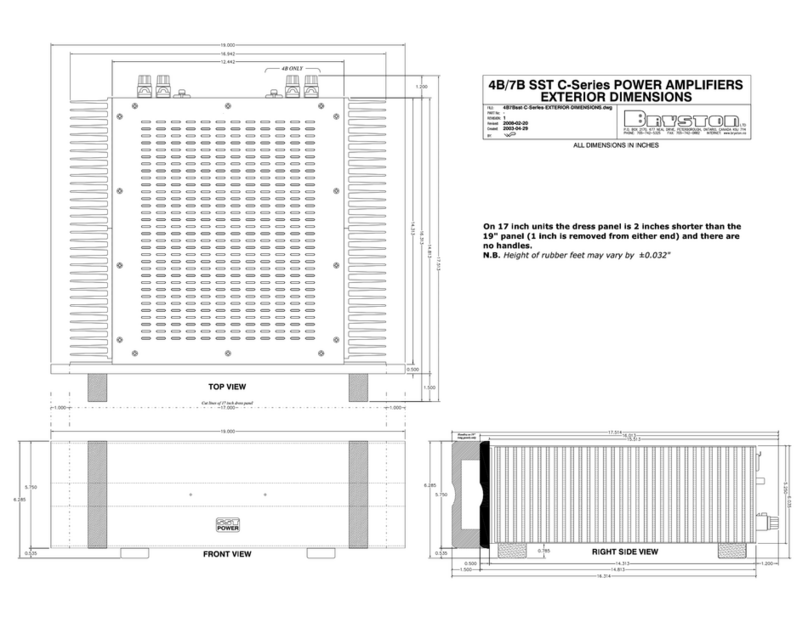
Bryston
Bryston C Series 4B SST Dimensional drawing
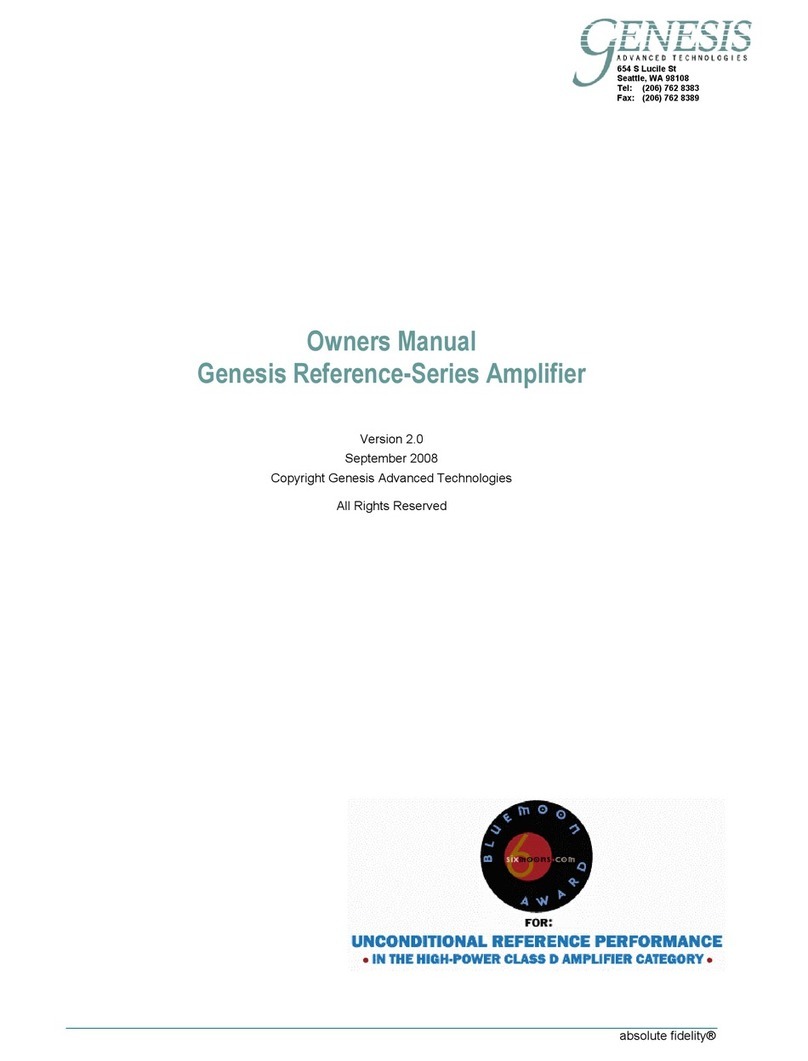
Genesis
Genesis Genesis Reference-Series Amplifier None owner's manual
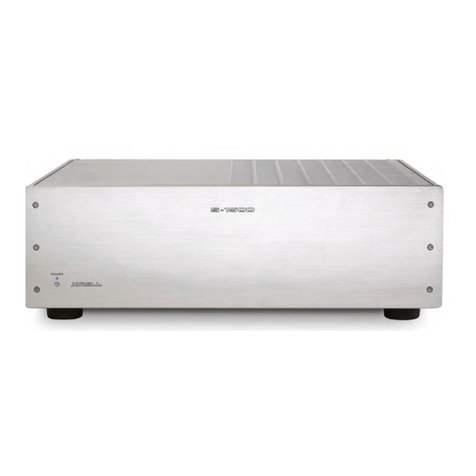
Krell Industries
Krell Industries S-1500 Instructions for use
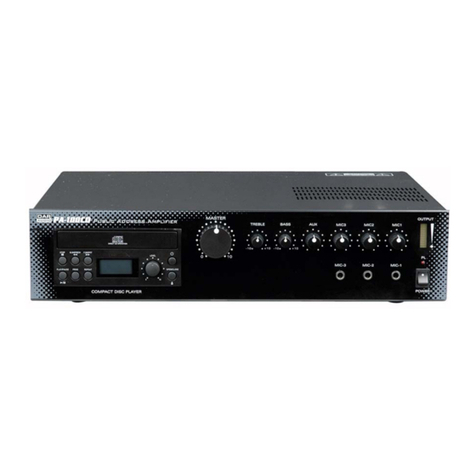
DAPAudio
DAPAudio PA100CD user manual




